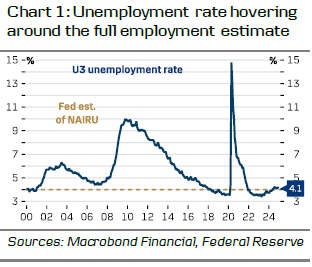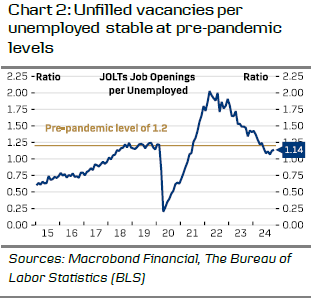The cooling trend observed in the US labour market since the late 2022 appears to have paused, but at a level where the labour market generally remains well balanced. The December Jobs Report came in stronger than expected, with nonfarm payrolls ticking up by 256k (cons: 160k), corroborating solid job growth after hurricanes and strikes distorted past readings. Prior figures were revised modestly down by a cumulative 8k. The unemployment rate edged down somewhat to 4.1%, hovering around most fullemployment estimates (chart 1).
The November JOLTs report provided some mixed signals, as job openings beat expectations (8.1m, cons: 7.7m, prior: 7.8m) but hiring slowed and involuntary layoffs ticked slightly higher. Altogether, it seems labour demand remains at healthy levels, with job openings reaching the highest level since May 2024. The ratio of unfilled vacancies per unemployed is stable, close to its pre-pandemic average (chart 2).
Wage growth declined to 0.28% m/m SA in December (prior: 0.4%) with the yearly measure at 3.9% y/y. For now, wage growth remains somewhat elevated, but with past years’ solid productivity gains, firms’ unit labour costs have remained in check. Recent signs of consumers’ inflation expectations ticking higher – both 1y and 5y according to data from the University of Michigan – could pose an upside risk to labour costs if workers begin to demand higher wages again. For the time being, Atlanta Fed’s estimation has suggested that job switchers no longer earn unusually high wage increases relative to those staying at their jobs.
Leading indicators provide a somewhat ambiguous picture. On the one hand, the ISM employment indices suggest that employment is weakening in the manufacturing sector but remains strong in services. Conversely, the PMI employment indices signal increasing employment across the board. We recommend interpreting the volatile data with caution.
Overall, data affirms the notion of well-balanced labour markets with no clear signs of overheating. This is good news for the Fed, and a key reason for why we still believe the Fed will cut rates in March despite the strong jobs report. However, conditions could become uncanny if labour markets begin to show signs of renewed tightness – particularly as the unemployment rate remains close to most full-employment estimates.
Weakening growth in labour supply, which was the backbone of past year’s stronger than expected macro environment, could pose two-sided risks to current labour markets conditions. BLS’ data shows that native-born labour supply growth stalled in 2024, and that immigration was the main driver of positive supply growth (chart 3). At the same time, a study from CBO suggest that 73% of the past year’s net immigration was undocumented workers – and as we have flagged before, inflow of undocumented immigrants already slowed in H2 of 2024. Importantly, while strong labour supply growth was one of the key reasons the US economy outperformed expectations last year and inflation continued to moderate – tighter labour supply could put upward pressure on labour costs, reigniting inflation concerns or forcing some companies to reduce staff.
This publication has been prepared by Danske Bank for information purposes only. It is not an offer or solicitation of any offer to purchase or sell any financial instrument. Whilst reasonable care has been taken to ensure that its contents are not untrue or misleading, no representation is made as to its accuracy or completeness and no liability is accepted for any loss arising from reliance on it. Danske Bank, its affiliates or staff, may perform services for, solicit business from, hold long or short positions in, or otherwise be interested in the investments (including derivatives), of any issuer mentioned herein. Danske Bank's research analysts are not permitted to invest in securities under coverage in their research sector.
This publication is not intended for private customers in the UK or any person in the US. Danske Bank A/S is regulated by the FSA for the conduct of designated investment business in the UK and is a member of the London Stock Exchange.
Copyright () Danske Bank A/S. All rights reserved. This publication is protected by copyright and may not be reproduced in whole or in part without permission.
Recommended Content
Editors’ Picks

EUR/USD eases to daily lows near 1.0260
Better-than-expected results from the US docket on Friday lend wings to the US Dollar and spark a corrective decline in EUR/USD to the area of daily lows near 1.0260.

GBP/USD remains under pressure on strong Dollar, data
GBP/USD remains on track to close another week of losses on Friday, hovering around the 1.2190 zone against the backdrop of the bullish bias in the Greenback and poor results from the UK calendar.

Gold recedes from tops, retests $2,700
The daily improvement in the Greenback motivates Gold prices to give away part of the weekly strong advance and slip back to the vicinity of the $2,700 region per troy ounce at the end of the week.

Five keys to trading Trump 2.0 with Gold, Stocks and the US Dollar Premium
Donald Trump returns to the White House, which impacts the trading environment. An immediate impact on market reaction functions, tariff talk and regulation will be seen. Tax cuts and the fate of the Federal Reserve will be in the background.

Hedara bulls aim for all-time highs
Hedara’s price extends its gains, trading at $0.384 on Friday after rallying more than 38% this week. Hedara announces partnership with Vaultik and World Gemological Institute to tokenize $3 billion in diamonds and gemstones

Trusted Broker Reviews for Smarter Trading
VERIFIED Discover in-depth reviews of reliable brokers. Compare features like spreads, leverage, and platforms. Find the perfect fit for your trading style, from CFDs to Forex pairs like EUR/USD and Gold.

